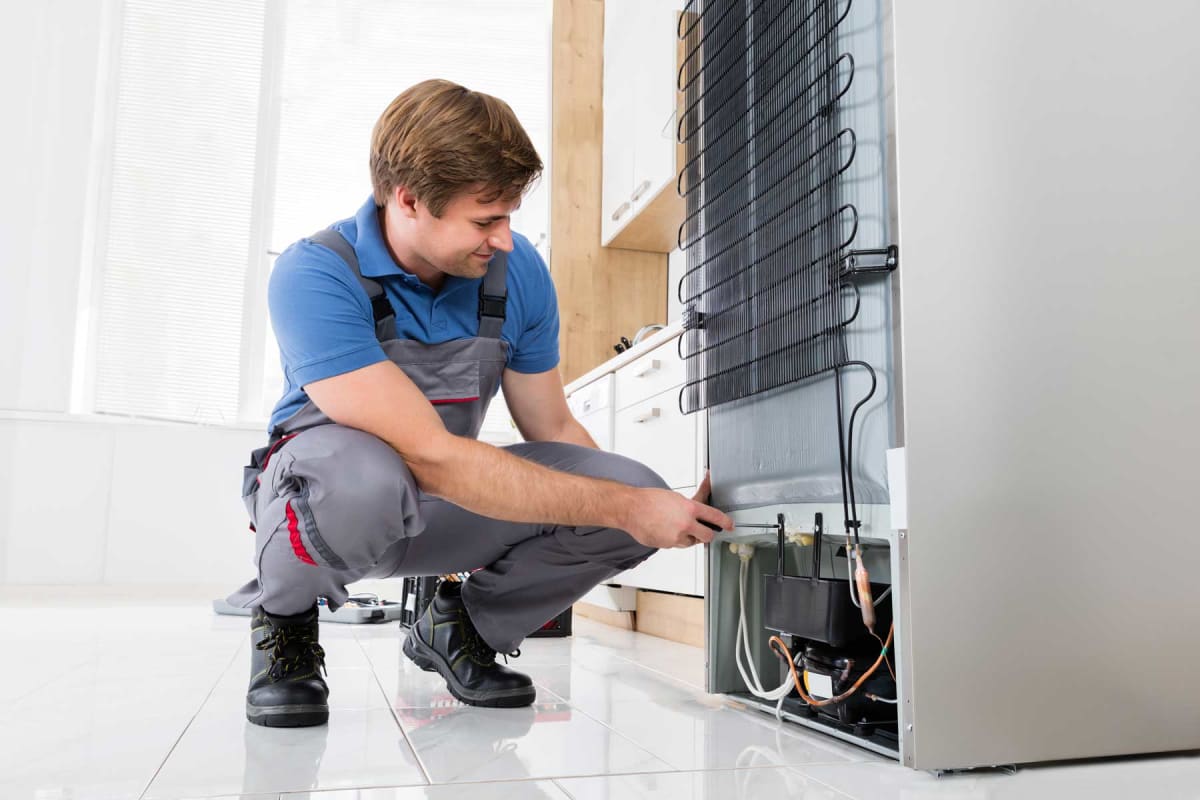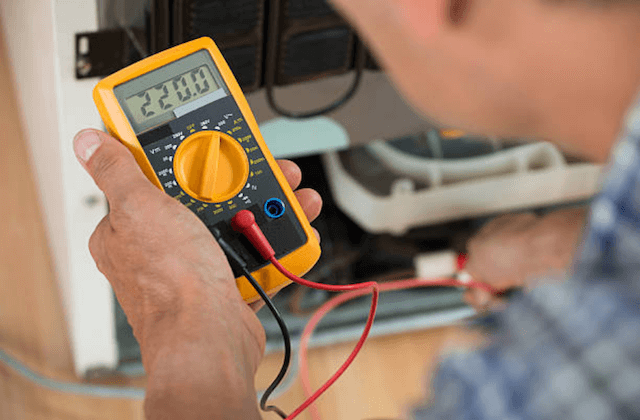What Happens When You Delay Small Repairs—Call Dependable Refrigeration & Appliance Repair Service Today
What Happens When You Delay Small Repairs—Call Dependable Refrigeration & Appliance Repair Service Today
Blog Article
The Ultimate Overview to DIY Appliance Fixing Methods
When appliances damage down, it's very easy to feel overloaded. Dependable Appliance For SubZero Freezer Repair. However with the appropriate understanding and devices, you can tackle usual issues yourself. From fridges to dishwashing machines, understanding exactly how to troubleshoot and fix these tools can save you time and cash. Are you all set to discover necessary methods that will empower you to manage fixings confidently? Let's check out the vital areas where do it yourself abilities can make a significant difference.
Comprehending Typical Home Appliance Problems
When you depend on your home appliances, it can be frustrating when they unexpectedly quit functioning or act up. Comprehending common device troubles can assist you troubleshoot issues efficiently.
If your oven isn't home heating, defective elements or thermostat concerns might be at fault. Dishwashers typically experience troubles with water drainage, so ensure the filter is clean and the drainpipe tube isn't kinked.
Additionally, listen for unusual noises; they often suggest mechanical concerns. By acknowledging these signs, you can conserve time and potentially prevent pricey repair services. A little knowledge goes a lengthy method in maintaining your home appliances, so remain informed to maintain whatever running efficiently.
Important Devices for DIY Repairs
Prior to diving right into DIY home appliance repairs, it's crucial to collect the right tools to guarantee the process goes efficiently. Start with a great collection of screwdrivers, including both flathead and Phillips, as they're important for opening most home appliances. You'll additionally desire a pair of pliers for grasping and turning cables or small elements.
Do not neglect a multimeter; it helps you test electric parts and diagnose problems properly. An outlet collection is convenient for loosening or tightening screws, while an utility knife can be beneficial for opening up or cutting cables product packaging.
Finally, consider having a flashlight handy to brighten dark rooms inside your devices. With these important tools, you'll be fully equipped to deal with different repair services, conserving both time and cash. So, gather your gear and prepare to roll up your sleeves!
Safety First: Safety Measures to Take
Before you start any type of home appliance repair service, it's essential to prioritize security. Ensure you use personal protective tools, separate the source of power, and keep your job location arranged. These straightforward preventative measures can aid avoid crashes and assure a smoother repair process.

Individual Safety Equipment
Security equipment is a crucial part of any type of do it yourself device fixing task. You should always wear safety goggles to safeguard your eyes from dirt and particles. A strong pair of handwear covers will certainly shield your hands from sharp edges and dangerous materials. Think about utilizing a mask if you're taking care of chemicals or dirt, guaranteeing you breathe securely while functioning. Steel-toed boots are additionally a clever option, particularly when raising hefty devices. Do not forget to use lengthy sleeves and trousers to protect your skin from potential injuries. By focusing on individual safety equipment, you'll considerably decrease the risk of injuries and accidents. Bear in mind, being prepared with the right gear maintains you risk-free and concentrated on completing your repair work successfully.
Source Of Power Interference
To ensure a risk-free Do it yourself device repair work, detaching the power resource is necessary. This simple action avoids electric shocks and warranties that you can concentrate on the repair service without worrying regarding unexpected activation. When you're positive that the power is detached, you can confidently continue with your fixings, knowing you've taken the necessary preventative measures to safeguard on your own.
Workspace Company
A well-organized workplace can make all the difference in your do it yourself home appliance repair work job. Beginning by clearing your work area of mess to stop disturbances and accidents. Set out all your devices and products, organizing comparable products with each other for simple accessibility. Use a tool kit or organizer to keep little parts like washing machines and screws had and identified. See to it you've got sufficient lights; it'll aid you see details clearly and reduce the risk of blunders. Do not forget to keep security gear like gloves and goggles within reach. Have a garbage bag convenient to dispose of waste without delay. A neat area not only increases performance but also maintains you safe while you work with your appliance repair work.
Step-by-Step Guide for Refrigerator Fixes
When your fridge begins acting up, it can be irritating, but dealing with the problem yourself can save you time and money. Initially, disconnect the fridge to ensure safety. Look for common issues like temperature fluctuations or uncommon noises. If it's not cooling down, inspect the thermostat settings; they could be established expensive. Next off, clean the condenser coils, which frequently gather dirt and particles. For a loud refrigerator, examine the fan and verify it's not obstructed.
If there's water pooling within, inspect the door seals for damage or dust, and tidy them if essential. For ice build-up, clear the defrost drain. Once you have actually dealt with the problem, plug the fridge back in and check it for a couple of hours. If the problem continues, you may need to replace a malfunctioning component, like the compressor or follower electric motor. Remember, don't hesitate to consult the guidebook or look for professional aid if required.
Dealing With Cleaning Equipment Issues
Similar to deep fryer repair fridges, washing machines can provide their own set of obstacles, however many problems can be fixed with a little troubleshooting. Initially, if your maker won't start, inspect the power cable and verify it's plugged in. Next off, inspect the door latch; a damaged latch can prevent the cycle from beginning. It could be due to international items stuck in the drum or the drainpipe pump. if you see unusual noises throughout procedure.
Tightening these can often solve the trouble. Regular maintenance, like cleaning the filter, can stop numerous concerns from emerging.
Fixing Stoves and Ranges
Just how can you repair common concerns with your stove or oven? Start by examining the power supply. Make particular it's plugged in and the circuit breaker is not stumbled. Verify the gas shutoff is open if it's a gas oven. Next, test the heaters: if they don't ignite, cleanse the igniter and look for clogs in the heater ports.
If your stove isn't heating, inspect the temperature level setups and verify the door seals tightly. A damaged heating component could additionally be the perpetrator; you might require to replace it if it's damaged.
For irregular food preparation, rotate your frying pans and consider making use of an oven thermostat to verify accurate temperatures. Lastly, if you hear unusual sounds or scent gas, turn off the home appliance right away and consult a specialist. By adhering to these actions, you can identify and fix several usual oven and range concerns successfully.
Repairing Dish Washers Facilitated
When your dishwasher starts acting up, it can be discouraging, yet resolving common issues isn't as tough as it appears. You'll find out detailed troubleshooting methods that will assist you identify the trouble, along with the crucial devices you'll require to tackle repairs yourself. Let's make fixing your dishwasher a breeze!
Usual Dishwashing Machine Concerns
While dishwashers are created to make your life less complicated, they can in some cases run into common problems that leave you feeling discouraged. One constant trouble is inadequate cleansing performance; this usually happens due to clogged up spray arms or unclean filters. You may likewise observe water pooling at the bottom, which can indicate a kinked tube or a damaged drainpipe. It can be a straightforward problem with the latch mechanism or door seal if your dishwasher's door won't latch. Additionally, strange sounds can indicate worn-out components or loosened components. If you smell something odd, it could be time to inspect for food debris or a malfunctioning electric motor. Attending to these issues early can conserve you time and headache later on (Best Sub-Zero repair Service Dependable Refrigeration & Appliance Repair Service).

Step-by-Step Troubleshooting
Prior to diving into fixings, it's crucial to identify the certain issue your dishwashing machine is facing. If it's not cleaning up effectively, Begin by examining. Examine the spray arms for obstructions and assurance they rotate freely. If it's dripping, analyze door seals and hoses for any type of damages. For strange sounds, listen very closely during cycles; foreign things may be stuck in the filter or impeller. Examine the power supply and door latch if your dishwashing machine will not begin. Don't fail to remember to consult your individual guidebook for troubleshooting tips certain to your version. By methodically attending to each possible concern, you can pinpoint the problem and take the needed actions to fix it, making your dish washer function like new once more.
Crucial Repair Work Tools
Having the right tools at your disposal can make all the difference when repairing your dish washer. Do not fail to remember a bucket or towels for any kind of water spills during fixings.
You may also desire a level to guarantee your dishwasher's appropriately aligned. With these necessary tools, you'll be well-equipped to deal with any kind of dishwasher fixing challenge that comes your method.
Frequently Asked Concerns
Just how Do I Identify if a Device Is Worth Repairing?
To determine if a device's worth fixing, consider its age, repair expenses, and present worth. If repairs exceed half the replacement cost, you may wish to purchase a brand-new version instead.
Can I Locate Substitute Parts Locally for My Home Appliance?
Yes, you can commonly locate substitute parts locally for your device. Check equipment shops, appliance fixing shops, or regional classifieds. Do not fail to remember to bring the design number to ensure here you obtain the appropriate part!
When Repairing Devices?, what Common Mistakes Should I Avoid.
When fixing devices, prevent hurrying with diagnostics, disregarding safety preventative measures, or utilizing inaccurate tools. Don't avoid reviewing guidebooks or seeing tutorials; they give essential assistance. Hold your horses and comprehensive to ensure successful repair work and prevent further damages.
The length of time Does a Typical DIY Home Appliance Fixing Take?
A common do it yourself home appliance repair usually takes one to three hours, depending upon the complexity. You'll wish to collect your devices and materials initially, and comply with guidelines very carefully to avoid unneeded delays.
Are There Any Guarantees for DIY Appliance Fixes?
When you tackle do it yourself device fixings, service warranties commonly don't cover your job. Some makers could honor guarantees for parts you replace. Always examine your appliance's warranty terms before beginning any kind of repairs to avoid issues.
Before diving into Do it yourself device fixings, it's important to gather the right tools to ensure the procedure goes efficiently.Prior to you start any type of home appliance fixing, it's essential to prioritize security.To ensure a risk-free DIY home jims appliance repair appliance repair service, disconnecting the power resource is necessary.An efficient job location can make all the distinction in your Do it yourself home appliance repair service job. Constantly check your home appliance's guarantee terms prior to starting any repairs to avoid concerns.
Report this page